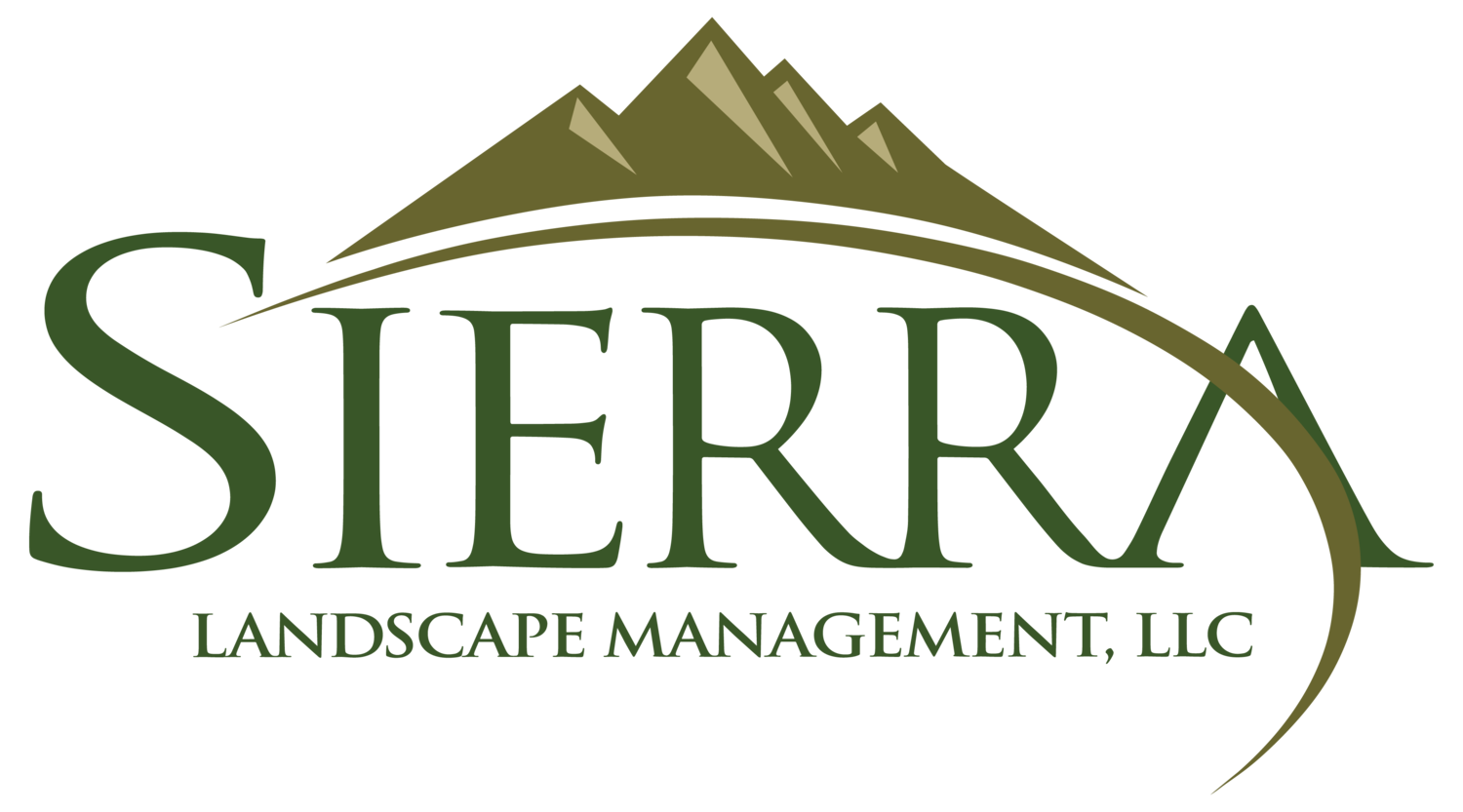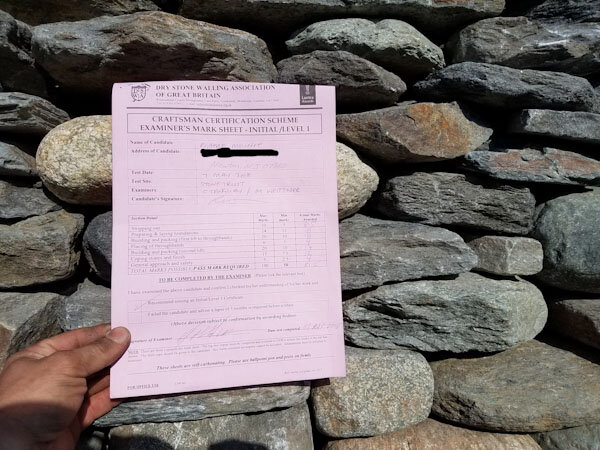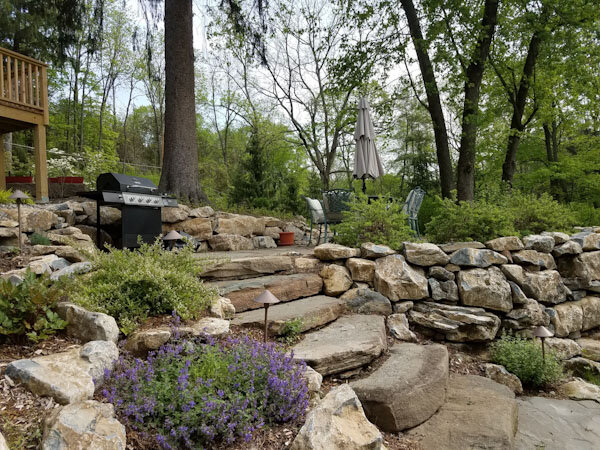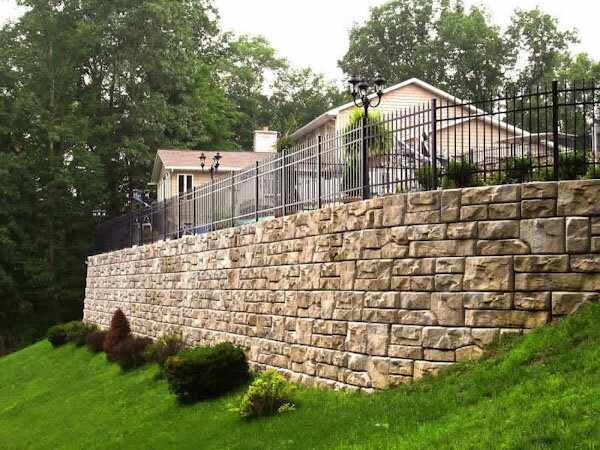Cost Comparison – Retaining Walls for Sparta, NJ
As a Landscape Contractor I find myself admiring not only my own work, but also the work of my fellow Outdoor Living Companies near Lake Mohawk in Sparta, NJ. Here is a beautiful retaining wall built in my area.
Rain, wind, and regular wear and tear can cause significant erosion to your yard. Flat ground is almost always more useful than a steep slope.
Coupled with landscape lighting, vibrant plants, and the right materials a retaining wall doesn’t have to be just functional. It can also become a highly attractive aesthetic feature for your property.
What features would you like to see in your retaining wall?
Here are a few common options and their costs to help you decide which retaining wall might be right for you.
Natural Stone – Dry Stack
OK, let’s get this cleared up from the start. This is by far my favorite. Perhaps this is because I am a sucker for taking on a challenge. Dry stone wall building can be fun, beautiful, warm, inviting, functional and very unique. It also requires proper training, practice, skill and a discerning eye to do correctly. There are many different options with this group, and the end result is only limited by the imagination of the stone artist. At Sierra we invest regularly in our team to ensure that they are properly trained in this style of wall building. I myself am proud to be one of less than a handful of people in the State of New Jersey that carries certification from the Dry Stone Walling Association.
There are a few challenges to this style of wall though. Primarily, this wall is very difficult to get approved for large builds, especially walls exceeding 4 foot in height. This has nothing to do with the wall itself, dry stone walling is the world’s oldest building technique (think Pyramids, Machu Picchu, etc.). However, in the fast paced world we live, very few engineers have invested in learning this style of wall construction, so getting one to sign off on a wall built this way can be expensive and time consuming. In everyday cases, these walls are best left to landscape designs without structural needs.
The cost of this style of walling is on the upper end of the scale because of the additional time and labor required to create a proper wall. Expect when discussing these types of walls to see costs in the $140 - $100 per square foot.
Natural Stone – Boulders
It is very common in certain regions to see large amounts of boulder walls. If you have ever dug a hole in Northern NJ I’d be willing to bet you found a few rocks at least. Imagine the rocks that get dug up when large excavation projects take place such as house foundations and swimming pools. In most cases it is just a matter of convenience why these walls exist. Large boulders get dug up and removal can be very expensive. Likewise, the property owner might need to flatten an area and the newly excavated boulders provide a great solution for the wall construction. Large boulders are very strong, and provide a very commanding presence when used correctly within a landscape.
Boulder walls can be purely functional, or with some careful planning can also provide an attractive solution for retaining wall needs. These walls also create great habitats for small animals and wildlife further adding to their value. Be warned though, these boulders are often very heavy, difficult to move, and can be very rough on equipment.
It is very common to hear that a potential client has a surplus of boulders around their property. Although this could be a great option for the project to gain inspiration, the feasibility of farming these rocks often makes it not practical. Rest assured there is no shortage of rocks for sale in our area.
Costs to install a boulder wall will be driven by the rock types, design selections, and accessibility. It can also be difficult to get engineering approval for these walls as well. Expect price ranges to be $50-$115 per square foot depending on the challenges.
Concrete – Masonry
Ok picture in your mind foundations, bridges, tunnels, etc. Concrete is an amazing product that has allowed for advancements in infrastructure all over the world. Concrete by design has very high compressive strength which makes it a great option for structural needs carrying a lot of weight. Concrete does not however flex very much which is why it can crack. Concrete used in retaining walls can be a great option when the application is structural and speed and efficiency are important. Concrete is relatively easy to engineer and can be installed in difficult to access areas because of the tools available for transportation and finishing of the material.
Concrete does require knowledge of the product and skill to finish. It often requires specialized tools and heavy equipment to work with. Because of its mass availability and low time of installation though the costs will often range in the $30-$85 per square foot and an additional $20-$60 per square foot additional for finishing ranging from stucco to veneer stone.
Concrete – SRW Block
The most common style of retaining wall installed in the average landscape in most regions today is SRW Block – Segmental Retaining Wall. SRW Block systems are easily available in most markets. The systems are easily able to be engineered making them a very common solution for structural and landscape installations. Unlike concrete wall systems, SRW walls are designed to flex with normal earth movement meaning they are an ideal choice for climates prone to harsh winters and seismic activity. They are easily transported using common construction vehicles and can be relatively easy to install with a smaller learning curve.
Because these products are manufactured for the masses they are also designed to meet the needs of the masses. Wall blocks can be manufactured to have a commercial style appearance, and they can also be created to mimic the appearance of stone walls.
Although these options can be easily had, they also can be a little slower to produce in certain situations. Expect for costs from a NCMA Installer to range $45-$90 per square foot.
Concrete – Large SRW Block
As SRW Block manufacturing techniques improve, Large SRW Block systems are becoming more and more common in residential landscape designs. Once reserved for industrial, commercial and infrastructural needs these large blocks allow for the benefits of SRW construction with the addition of some benefits borrowed from structural concrete applications.
These styles of wall were once rejected by many municipalities in residential applications because of their appearance. Currently, these walls are gaining popularity and we are seeing them approved and used in residential wall needs over 4’ in height, more and more. The one challenge of these walls is the blocks size. Large and heavy machinery is required to move these blocks sometimes weighing in excess of 6000 pounds each. This means hiring an experienced company familiar with heavy construction, site planning, logistics, and safety protocols is a very important consideration.
The main benefit of these walls is speed, longevity and their structural benefits. They are on the upper end of the wall range because of the logistical requirements and material cost, but that is often recovered over the life of the property. The Cost for these systems ranges from $90-$150 per square foot in most residential settings.
Gabions
I had to throw this in because their popularity in residential applications is growing. Gabions are metal cages filled with rock. They are very popular in highway, drainage, slope stabilization and modern architecture applications. They combine some of the bearing strengths of the Large SRW Block walls but because they are pieced together on site they can be installed in difficult to access locations. Modern versions of this style are taking the design benefits of the technique and adding artistic flair in the metal work and rock placement to create truly unique features.
Costs will vary greatly from industrial to architectural applications. Expect to see costs in the range of $40-$125 per square foot.
Note: We are not including wood walls in the article because the overall cost is no longer feasible for most applications. The cost of wood has increased to the point where buyers of wood walls are doing so for aesthetic reasons. The cost is often comparable to or exceed SRW pricing.
Check out this popular video on our YouTube channel showing how a wall gets built!
We hope this article helps in your journey researching Retaining Wall Cost. Check our Buying Guide for more Outdoor Living pricing.








